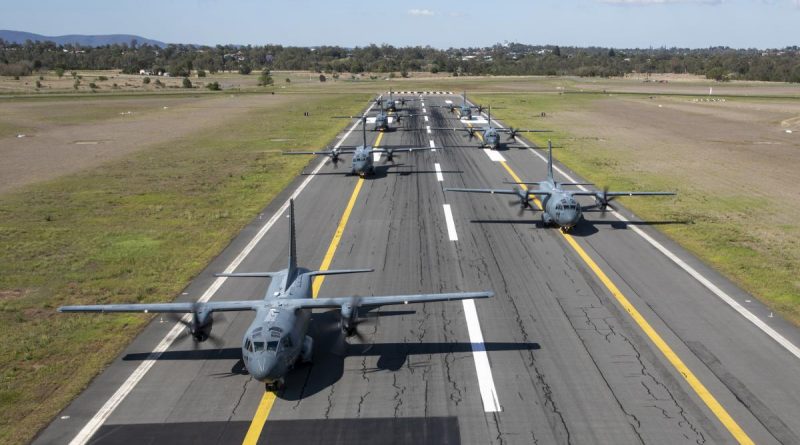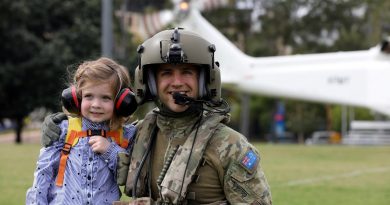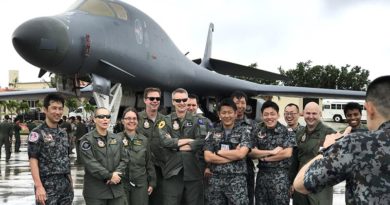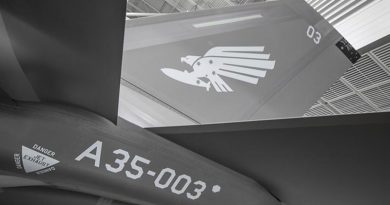March of the Spartans

‘March of the Spartans’ by No. 35 Squadron has demonstrated its readiness to deliver airlift support during contingency operations.
CAPTION: C-27J Spartan aircraft from No. 35 Squadron on the cross-strip runway prior to take off, at RAAF Base Amberley, Queensland. Story by Eamon Hamilton and Flying Officer Lily Lancaster. Photo by Leading Aircraftwoman Emma Schwenke.
On October 19, aviators simultaneously launched seven C-27J Spartans at RAAF Base Amberley, with an eighth Spartan already interstate on a separate task.
Massed launches such as this are also called an ‘elephant walk’, describing the trail of aircraft taxiing to the runway.
Commanding Officer of No. 35 Squadron Wing Commander Scott Egan said it was the first time any global C-27J operator had conducted a mass launch on this scale.
“Defence remains ready to provide relief to communities in Australia and across the region, and evacuate people to safety,” Wing Commander Egan said.
“The C-27J Spartan is one of many Defence capabilities that can provide vital support to the nation, and our near region, particularly as we enter the high-risk weather season.
“The mass launch demonstrates that No. 35 Squadron is prepared to support whole-of-government operations and deliver that response to remote airfields.”
Air Force has a fleet of 10 C-27J Spartans, providing a light tactical airlift capability between Army’s rotary-wing fleet; and larger Air Force transports such as the C-130J Hercules and C-17A Globemaster III.
Each aircraft can carry up to 40 passengers or five tonnes of cargo.
Flight Lieutenant Sean Joyce, a pilot at No. 35 Squadron, was responsible for coordinating the March of the Spartans.
“It took diligent effort and many prudent decisions by everyone involved to ensure that the launch went smoothly,” Flight Lieutenant Joyce said.
“Decisions that many of our aviators made on the day directly ensured that it was successful.
“I’m really quite proud of what we were able to achieve as a squadron; it is an uncommon opportunity and we seized it.”
The March of the Spartans was built around the routine practice of preparing and launching the C-27J, but required coordination and simultaneous actions across seven aircraft.
Aircrew planned an achievable timeline and ancillary details including taxi order and positions of aircraft, radio-call phraseology and coordination, and contingency actions.
Maintenance personnel, however, had a significant stake in the March of the Spartans being successful.
“It takes time to prepare an aircraft for a day of flying, as well as to launch and recover planes,” Flight Lieutenant Joyce said.
“Usually this is done with a time-based stagger to give technicians sufficient time and space to ‘turnaround’ aircraft and deal with any problems.
“For March of the Spartans, they now had to do all of this simultaneously for seven aircraft.”
This meant using shared resources and balancing manpower with other operations.
“It was a fantastic achievement by our maintenance and logistics team that we were not only able to prepare and launch all aircraft for the day simultaneously, but that all aircraft were ready early,” Flight Lieutenant Joyce said.
Squadron Leader Justin van Beuningen, Senior Engineering Officer for No. 35 Squadron, said the mass launch also reflected the success of recent maintenance reforms.
“Since January 2020, we’ve completed a number of maintenance reforms to improve the fleet health as well as the availability and sustainability of the C-27J,” Squadron Leader van Beuningen said.
“While there’s been a significant amount of work from our own maintenance and logistics teams, the reform would not have been possible without the support of C-27J enterprise partners.
“These include No. 84 Wing, Air Lift Systems Program Office, and our through-life support contractor Northrop Grumman Australia.”
The most significant reform has been the implementation of the Rolling Maintenance Program.
“This grouped together scheduled servicings and deferred defect rectification, optimising the maintenance down-time of aircraft and reducing the frequency of unserviceability,” Squadron Leader van Beuningen said.
“Additional improvements included the development of the Unit Maintenance Plan, as well as increased input into Fleet Planning.”
Experience with operating and maintaining the Spartan has grown since the first RAAF aircraft arrived at RAAF Base Richmond in June 2015, followed by No. 35 Squadron relocating to RAAF Base Amberley in early 2019.
“No. 35 Squadron is now able to create more manageable tasking workloads for the aircrew and maintenance workforce,” Squadron Leader van Beuningen said.
“We’ve benefitted from improved communications and planning between maintenance and operations cells, which has given us greater awareness of maintenance constraints and what that means for availability for tasking.”
.
.

.
.





